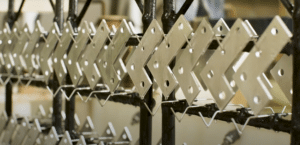



Protection of metal fabricated components is critical to the long-term durability of the final product. Surface finishing through powder coating or wet painting are both common solutions to protect various components. Both powder coating and wet paint systems contain similar resins, additives, and pigments; however, there are marked differences between these two painting systems. Most notably, wet paint systems require the use of solvents to suspend the mixture in the fluid form.
Powder coating is applied as a dry powder without solvents, however, the powder paint must be baked or cured on the surface of the part. This primary difference in application method results in several advantages and disadvantages between these two coating options. Continue reading
One of the greatest shortcomings for the longevity of copper, brass, or even stainless steel contacts is corrosion of the base material. This issue is a greater problem in harsh or extended duty contacts which is why gold plating is preferred for these applications.
Gold plating deposits a noble gold layer that will not corrode or form oxides or compounds even at elevated temperatures or when exposed to highly corrosive environments. An added benefit is that gold is a better electrical and thermal conductor than the many of the base materials contacts are fabricated from. Continue reading
Electroplating is among the most critical processes used in modern manufacturing today. With the Internet of Things (IoT) more and more devices are connected to provide instant access to information and data. However, any electrical device’s effectiveness and reliability depends highly upon the quality of the connections and specifically the plating used on the connector or contacts. Proper electrodeposition is key to ensuring a device performs reliably whereas improper plating can negatively affect performance, utility and durability of the electrical device.
When it comes to plating electrical components such as connectors and contacts, gold and silver are two common electroplating processes that produce highly reliable and conductive connections. However, there are advantages and disadvantages between silver and gold plating services. Both gold and silver are highly conductive and corrosion resistant; however, silver will form a sulfide compound (tarnish) and gold can be a costly option. In this article, we’ll be discussing the difference between gold and silver connectors and when one coating might be preferable over the other.
The value of gold as a noble metal has been observed for centuries across a range of decorative, functional, and industrial applications. In an increasingly connected world, the benefits of gold plating are being utilized like never before for high reliability contacts and connectors to ensure rapid and reliable signal transmission. Since 1948, Advanced Plating Technologies (APT) has delivered gold plating services across an array of demanding industries, including the interconnect and medical sectors as well as the Telecommunication and defense industries.
As an ISO 9001:2015 & 13485:2016 certified and ITAR registered company, Advanced Plating Technologies provides gold plating services for even the most demanding applications. APT offers barrel, rack, and vibratory plating of loose-piece components in hard and soft gold as well as duplex gold plating. APT offers 99.9% pure (Type III) soft gold and 99.7% purity hard gold (Type I or II) and can provide a range of underplate combinations to meet nearly any ASTM, Military or OEM specification. Continue reading
Metal Finishing Environmental Stewardship Benefits More Than Just the Environment
Advanced Plating Technologies has always taken a clear stance on the environment. Since the beginning of the clean water act in 1972, APT has been committed to not only meeting but exceeding all local, state and federal environmental laws. This record speaks a silent assurance that many “low cost” metal finishing suppliers cannot. In fact, metal finishing companies with substandard environmental systems is a liability not only for their continued operation but for potential litigation down the road against themselves and their customers.
The metal finishing industry continues to be one of the most highly regulated industries in the country with new regulations and requirements added each year. New regulations on PFOA and PFOS compounds and additions to the Toxic Substances Control Act (TSCA) are just a few of the latest impending regulatory restrictions. For this reason, APT continues to invest in improved treatment technologies and self-imposed compliance standards below permit levels as an example within the Industry. APT’s leadership has been recognized with numerous local, state and national environmental awards from the Milwaukee Metropolitan Sewage District (MMSC), Wisconsin State Department of Natural Resources (DNR) and the United States Environmental Protection Agency (EPA).
The history of environmental compliance within the metal finishing industry is marked by various landmark laws that have far-reaching implications counter to what many would consider sound environmental practices. In 1980 the Resource Conservation and Recovery Act (RCRA) mandated that the F006 wastewater treatment sludge produced by electroplaters shall be listed as hazardous waste categorically. This designation was applied without testing the waste product for its actual chemically hazardous profile using the TCLP methodology. Thus, the applied arbitrary designation limits the ability of the waste to be recycled to recover the valuable metals contained therein. Since then, this legislation has come under increased criticism from many in the industry as it results in the waste of thousands of tons of valuable metals each year. Continue reading
When it comes to selecting a coating for your firearm or firearm components there are several key features you need to consider. When going through options you need to ensure your firearm finish can meet several key characteristics such as the ability to hold tight tolerances, provide enhanced lubricity, wear resistance, corrosion protection, and, of course, provide a uniform and consistent black appearance.
Advanced Plating Technologies has worked hand-in-hand with numerous firearm OEMs throughout the years to provide a superior black finish that meets all the above requirements. Tacti-black® HP+ was developed in response to feedback received from numerous firearm OEMs that needed a finish that could meet all of the above requirements on a range of materials including steel, stainless steel, and aluminum.


Unlike common firearm coatings such as black oxide, nitriding, anodizing, and QPQ, Tacti-black® HP+ is “material blind” meaning it can be plated onto any metal material. This tactical firearm finish is perfect for a large array of firearm components like custom lower receivers, trigger sears, hammers, and stamped magazines.
APT can provide this proprietary tactical firearm finish to most any metallic substrate from CNC firearm components to 3D printed and MIM alloy components with a density of over 90%.
Gold has and continues to be a principle finish for electrical components especially with the continuing miniaturization of electronics. One of the primary benefits of gold plating services is a finish that is both conductive and receptive to soldering. When soldering gold plated components there are a variety of important considerations when specified the surface finish. The primary considerations are thickness, purity and the proper selection of an underplate.
Plating Thickness
Gold plating thickness is a critical, and often misunderstood, tenant of gold soldering. In gold soldering the physical bond is made between the underlying nickel layer and the solder itself, with the gold layer serving as barrier to help maintain the solderability of the nickel layer. Typical gold thickness for solderability is in the range of 10uin to 30uin as it provides adequate protection against oxidation to preserve wetting while keeping the cost of the finish as competitive as possible.
When soldering, gold dissolves into the solder through solid state diffusion. With heavier gold deposits, more gold alloys within the solder joint. In the diffusion process the gold reacts with the solder creating a gold intermetallic amalgam. If the gold in the solder exceeds 3% by mass, the solder joint can become embrittled causing joint failure, especially in dynamically or thermally stressed joints. The level of impurity and thickness of gold are directly related, thus thickness of the gold must be balanced between corrosion/oxidation protection, contact cycle life and solderability. (Soldering to Gold – A practical Guide).

Silver plating of copper or copper alloys is a highly functional finish for transferring heat and electricity utilized across a wide breath of industries. Silver has been applied since late 1800s on electrical switchgear and other components that pass electrical current. In recent years silver plating of copper electronic components including connectors and terminals has grown rapidly within the electronic, automotive and electric vehicle (EV) markets. Silver plating has many unique properties that make it desirable for these applications. The primary reason is that silver has the highest electrical and thermal conductivity of any metal, which facilitates the efficient transmission of electricity and heat. In addition, silver is a relatively soft metal which allows the silver deposit to compress and form around a mating connecter filling small voids and micro-roughness. This increases the effective contact area resulting in less overall connector resistance.
Silver has excellent lubricity and resists galling in switching, sliding or rotary applications. However, high-pressure wear surfaces such as blade-style stab connectors can be susceptible to silverwear. In applications such as this, a higher deposit thickness of silver is recommended as well as the use of a nickel or electroless nickel underplate. Thinner silver plating without a nickel underplate is best used on static joints or low duty cycle connectors that are mated and unmated relatively infrequently.
Stainless steel is an inherently corrosion resistant material, however when stainless steel is machined, formed or fabricated free iron can be introduced to the surface that can corrode independent of the base material. Proper passivation of stainless steel with an oxidizing acid such as nitric or citric acid removes this free iron and promotes the growth of a thin, dense protective oxide layer which maximizes the corrosion resistance of the stainless steel. Depending on the type of stainless steel and end application certain passivation processes may perform better at passivating than others. In this article we will compare nitric vs citric acid passivation which are the two primary chemistries specified in ASTM A967 and AMS 2700.
When comparing nitric vs citric passivation, the most common method used throughout industry is nitric acid passivation. The Nitric acid passivation processes was the original passivation processed specified in QQ-P-35, the first military specification covering passivation, revision A being released in the 1960s. Nitric acid passivation offers a range of options to customize the oxidizing potential of the acid to suit a specific grade of stainless steel. The various methods and types of nitric acid passivation include several heated options as well as options that include a sodium dichromate.